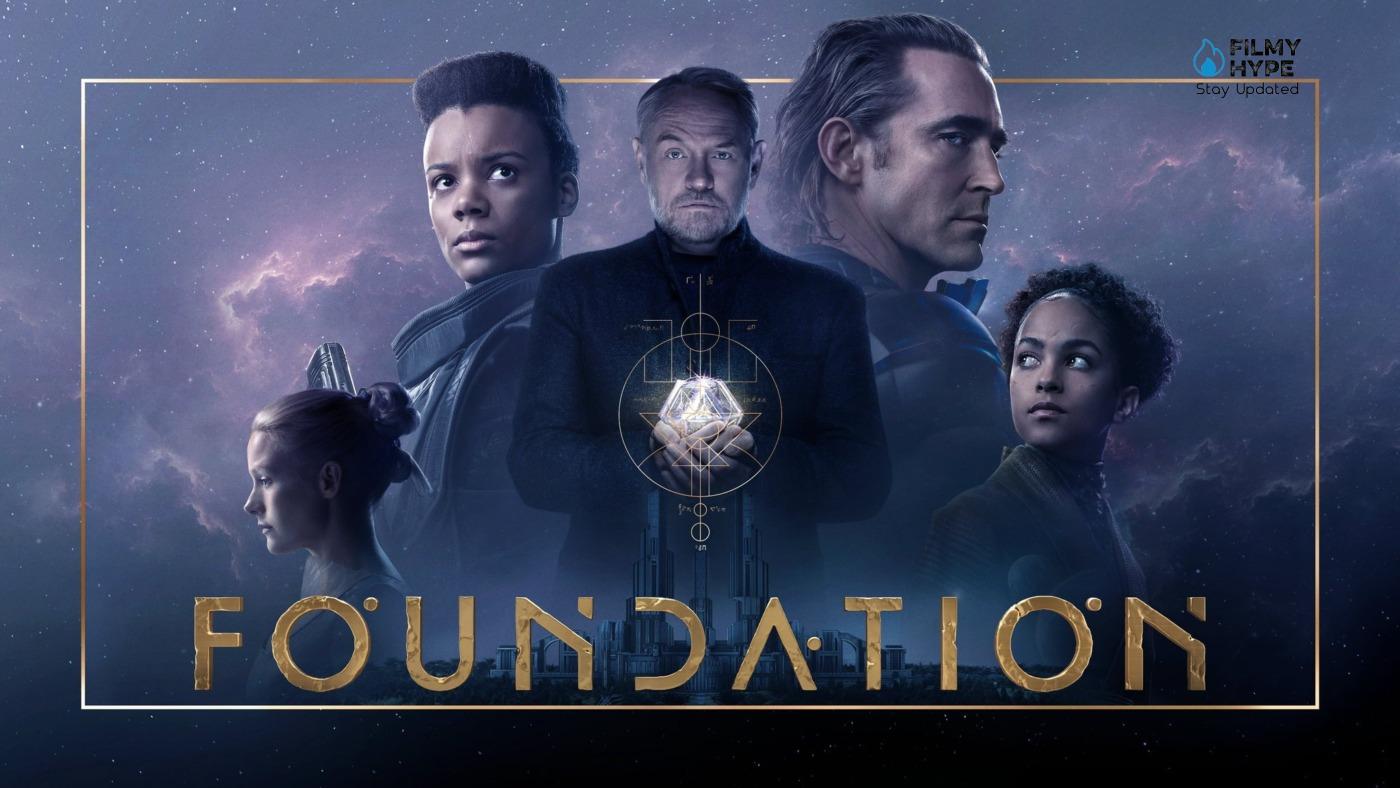Foundation Season 2: Is The Foundation Cycle! Can Predicting Humanity’s Future Be a Science?
Foundation Season 2 is all set to release on 14th July this year on Apple Tv+, here in this article, we are going to discuss The Foundation Cycle. Is there a precise science, a mathematical secret that allows you to predict the future? A theoretical curiosity that has found fertile ground in science fiction, both in literature and on the big screen. Great storytellers have grappled with this theory, as demonstrated by Minority Report, but it has found its most evident manifestation in a literary saga: The Foundation Cycle. Universally recognized as the father of the modern concept of robots, Isaac Asimov didn’t just break the Frankenstein syndrome but extended his future vision of humanity into a much larger narrative mosaic of millennial breadth.

The Foundation Cycle: Can Predicting Humanity’s Future Be a Science?
Like other great cycles of genre literature, such as Dune, The Expanse, or The Songs of Hyperion, The Foundation Cycle is considered an example of space opera, i.e., a long, complex fresco of a future galaxy in which there are common features, such as star empires located in remote space, great battles, and romantic elements. The Foundation Cycle respects most of these narrative assumptions, being also one of the first examples of them, a model that would later inspire other authors as well, such as Saberhagen and Orson Cott Card. What made The Foundation Cycle compelling today were the ideas and Asimov‘s insights into sociology and political dynamics.
The Origins of The Foundation Cycle
When Asimov began his career as a science fiction writer, publishing in the field had different rules than today. Giving space to sci-fi stories were anthological magazines that allowed different authors to submit their ideas, whether they were short stories or more articulated works, which would have been broken up to be published in several issues. Asimov also began his activity as an author by following these rules, sending his writings to various specialized magazines.
It was in this way that the first nucleus of what would become the Cycle of Foundations was presented to the public. Initially, Asimov proposed to Astounding Magazines, one of the most famous magazines in the sector, a series of stories set in a future Empire near collapse, in which a young scholar had conceived a new science that could prove to be the salvation of the galaxy.

Published between 1942 and 1950, these short stories were quite successful, so much so that the year following the conclusion of the cycle it was decided to create fix-up volumes, i.e. a novel in which these short stories, duly united by new contents, assumed a new, more organic dimension. From this intention, the first three volumes of the Foundations cycle arrived in American bookstores: Chronicles of the Galaxy (Foundation, 1951), The Collapse of the Central Galaxy (Foundation and Empire, 1952), and The Other Side of the Spiral (Second Foundation, 1953).
Chronicles of the Galaxy, The Collapse of the Central Galaxy, and The Other Side of the Spiral became known as the Foundation Trilogy, considered by many to be one of the pillars of science fiction, a belief that won Asimov the prestigious Hugo Award in 1966. recognition that came later than the first edition, which took place in the early 1950s, which was not successful, probably due to a lack of promotion of the volumes. The Foundation Trilogy was brought to fame by a la Doubleday, whose editor Tim Seldes decided to republish the three volumes after repeated requests from a foreign publisher.
Under this pressure, Seldes acquired the rights to the Foundation Trilogy and I, Robot, an anthology of robot stories; Duobleday decided to republish the Foundation Trilogy in a single, full-bodied volume, setting up a careful promotional campaign that had the merit of giving due prominence to Asimov‘s work, bringing it to the attention of science fiction enthusiasts and getting it noticed by the jury of the Hugo Awards. The origin of this saga was traced by Asimov himself to the essay Histories and Decadence of the Roman Empire (The History of the Decline of the Roman Empire), written by the English historian Edward Gibbon in the second half of the 18th century. According to Gibbon’s theories, the Roman Empire had met its end because its citizens had lost attachment to the res publica, resulting in a sense of detachment from their role as citizens and a progressive separation of the more remote areas of the Empire.
These ideas stimulated Asimov‘s curiosity, who considered them an interesting starting point for a new series of stories, an opinion also shared by his editor, the famous John W. Campbell, with whom the American writer elaborated the idea of a Galactic Empire, now close to collapse. Asimov was given another inspiration by cliodynamics, a scientific philosophy that sees the possibility of developing mathematical models to analyze historical and social dynamics. Cliodynamics is easily identifiable as the scientific root of the casus belli of the Foundations Cycle, psychohistory, the mathematical model elaborated by Hari Seldon, and the narrative basis of the Foundations Cycle.
After the Foundation Trilogy, Asimov seemed to have concluded this narrative parenthesis, but in the early 1980s, also at the request of his publisher, the novelist decided to expand his vision of the Foundation, giving life to other novels that expanded its context, both as a sequel and as a prequel. Starting in 1982, Foundation‘s Edge, Foundation and Earth, 1986, Prelude to Foundation, 1988 and Forward the Foundation, 1993 were released. The conclusion of the other side of the spiral was a non-definitive ending, considering how the prediction that it would take a thousand years before the appearance of a new Empire had become the harbinger of a feeling of incompleteness, given that the events of the novel had placed a few hundred years after the collapse of the Galactic Empire.
It was this aspect, combined with the insistence of the writer’s fans, that prompted Asimov to conclude his saga, leading to the transformation of the Foundation Trilogy into The Foundation Cycle. Central to these new novels is Asimov‘s attempt to bring the Foundation Trilogy back into a long, complex horizontal plot that also includes his other famous works. The presence of a character like R. Daneel Oliwav or the appearance of myths from remote times that impact certain social structures is the narrative tools with which Asimov reconnects to his other famous works, from The Cycle of the Robots to The Cycle of the Empire. Upon Asimov‘s death, his wife decided to follow up the saga with the Second Foundation Trilogy, entrusting the fate of the Foundations cycle to other writers. This choice turned out to be unfortunate, given that some typical elements of Asimov‘s narrative, both scientific and social, were completely distorted, creating a rift between the central corpus of the saga and these later works.
Why Read The Foundation Cycle?
Asimov‘s intention to see history as a didactic element for future generations was not entirely original. It would be enough to quote Orwell’s 1984 to see how the analysis of contemporary events can be traced back to a moral critique of the contemporary world for the benefit of future generations, but something new is recognized in Asimov: under scrutiny, it is not the present but the past. In particular, historical events are not analyzed as ends in themselves, but an attempt is made to bring these situations back into a broader social perspective, attempting to define a behavioral trend that can be canonized as a basis for predicting models that can also be applied in the future.
Hence the birth of psychohistory, a mathematical model in which by using the analysis of past events and the creation of a sort of social law it is possible to predict future situations. To arrive at the formulation of his science, Seldon travels through different cultures and sub-cultures, even in the capital world of Trantor, an occasion with which Asimov paints a future society permeated by a profound ignorance of its past and plagued by forms of racism, which undermine the very structure of the Empire. Psychohistory, therefore, becomes for Seldon a kind of moral obligation, his contribution to humanity to prevent the collapse of the Empire, considered as inevitable, from leading to an era comparable to the medieval Dark Ages, if not worse.
Asimov‘s intuitions that led to the formation of psychohistory, today, may be out of place, but the novelist must be granted that his intuition is contemporary with the first studies on Chaos Theory and Game Theory, shortcomings that are perceived in some visions of dynamics of this complex pseudo-science, whose axioms postulated by Seldon and his successors are sometimes scratched by the presence of characters that are difficult to trace back to a pre-established scheme.
At the basis of Asimov‘s science fiction, we have a kind of dogma: humanity is alone among the stars. While going beyond some stories (such as Half-Blood and Half-Blood on Mars), in the future of Asimov‘s great human epic alien civilizations are not contemplated, but only the human race seems to be the master of the cosmos. An axiom on which psychohistory is also founded, which considering only man as an element of analysis inevitably remains the trap of a series of deceptive stakes, knocked down with the appearance of an atypical element such as the Mule, a mutant whose incredible powers and mentalities put Seldon’s project at risk.
Asimov‘s future humanity, on closer inspection, shows the same flaws and potential as its contemporary. The revelation of a science-like psychohistory transforms Seldon into a potential pawn in dangerous power games, which Asimov narrates with escapes through the depths of Trantor and portrays a living and compelling social macrocosm. It cannot be hidden that some passages are forced and told in a bombastic language, with a concession to certain unsuccessful dialogues. However, the narrative background and the inspirations that guided Asimov emerge as needed, best embodied in a series of events and brought to life by captivating characters.
How to Read The Foundation Cycle?
Given the complex nature of The Foundation Cycle, establishing a reading order is not easy. One could follow a path that respects the conception of the seven different chapters or rely on a reading that moves along the right chronology of events. At the moment, to better enjoy the Fondazione Cycle you can rely on Fondazione – The complete cycle, recently released by Mondadori Dragon which collects all the chapters of this saga in one substantial volume, presented according to the chronological order of events. The books that make up The Foundation Cycle are Prelude to the Foundation, Foundation Year Zero, Foundation, Foundation and Empire, Second Foundation, The Edge of the Foundation, and Foundation and Earth. Prelude to the Foundation.
Prelude to the Foundation!
On the capital of the Galactic Empire, Trantor, Prime Minister Eto Demerzel is facing the final days of the reign of Cleon I. The signs of the collapse of the imperial order are increasingly manifest, but when the young mathematician Hari Seldon, seems to represent a hope for the throne. According to Seldon, it is possible to develop mathematical models with which to predict future events, using the mathematical science of his invention, psychohistory.
This invention makes the young mathematician an essential pawn in the power games of imperial politics, when Demerzel decides to capture him to use him as a tool to consolidate the power of Cleon I. Helped by the journalist Chester Hummin and the scientist Dors Venabili, Seldon becomes the prey of a manhunt that pushes him to travel through the different subcultures of Trantor, hiding and at the same time gathering information to develop his theory. During this escape, Seldon learns the legends of robots and meets the young Yugo Amaryl, a boy from one of the poorest areas of Trantor and a math enthusiast, with whom Seldon will form a father-son relationship. At the end of the volume, we discover the true identity of Hummin, a revelation that will forever change the fate of the empire and the life of Seldon.
Year Zero Foundation
After the events of Prelude to the Foundation, Seldon is again at the center of political interest, when the appearance of a demagogue who seeks to discredit Demerzel puts him in a difficult position. Forced to take over from Demerzel himself as prime minister, Seldon. An appointment that, after ten years, sees Seldon having to manage a conspiracy against him, which will end with the accidental death of the emperor, following which Seldon resigns to return to follow the development of psychohistory, ever closer to the definition of him.
His return to Streeling University, where his science was born, does not exempt him from the attention of the powerful, also putting him at the center of a new attempt on his life which will cause the death of someone dear to him, who will reveal the own nature in an attempt to save it. After this loss, Seldon concentrates on his work, culminating in the creation of a Foundation, a hub of scientists and knowledge keepers, on a remote planet, as security for the imminent collapse of the Empire. Unbeknownst to all, Seldon, after discovering that his niece Wanda possesses telepathic skills, decides to look for other gifted individuals, whom he defines as mentalists, to give life to a Second Foundation, unknown to all.
Foundation
The final moments of Foundation year zero are retraced, deepening the essential steps of the creation of the Foundation on Terminus and the creation of the Galactic Encyclopedia. These, as revealed decades later via a pre-recorded hologram by the now-deceased Seldon, will serve not to prevent the fall of the Empire, but to reduce the projected 30,000 years of barbarism to a single millennium before the rise of a new Empire. In these years, the Foundation will be guided by some Seldon messages, which will coincide with the so-called Seldon Crisis, moments whose repercussions will play a central role in the future of the galaxy.
Foundation and Empire
The Foundation becomes the target of an Imperial general, who manages to convince the emperor that this distant organization is a danger to the stability of the Empire. Despite not having its fleet, the Foundation manages to survive, discovering after the opening of the Vault that this clash had been foreseen, and could not in any way be avoided. One hundred years after this war with the Empire, the Foundation discovers the existence of the Mule, a mutant being with incredible mental powers that were not foreseen by Seldon, whose presence could destabilize the plans of the Foundation. Some members of the Foundation track him down to find out what his purpose is, eventually meeting the mutant and witnessing his rise to control of the Galaxy.
Second Foundation
After establishing his rule over the galaxy by defeating the Foundation, the Mule learns of the existence of the Second Foundation. To preserve his power, the mutant sets out on a galaxy-wide search, eventually coming to a standstill with the leader of the Second Foundation, the First Speaker, who defeats him by depriving him of his powers. The damage is done, however: now the Foundation knows the secret of Seldon. The Foundation sees a danger in his counterpart since his revelation prevents the continuation of the Seldon Plan, which envisaged humanity’s ignorance of a force that operated as a secret guide. A clash begins between the two Foundations, which will lead to a new balance in which the future of humanity returns to following the provisions of the Seldon plan.
The Edge of the Foundation
Five hundred years after the clash of the Foundations, the Seldon Plan is following its regular schedule. According to the experts of the Second Foundation, which survived unbeknownst to Terminus, this perfection is suspect, as if there were a third force at play protecting the Seldon Plan. Meanwhile, the Foundation is convinced that its counterpart is still active and sends scholars to search for it, but among them, there is also a historian obsessed with the myths of humanity’s original world, Earth. The two Foundations, without knowing it, set out in search of man’s original planet, until a confrontation that will have control of the galaxy at stake.
Foundation and Earth
Last Chapter of The Foundation Cycle. The search for Earth is still at the center of interest of a member of the First Foundation, who after finding the coordinates of the worlds of the first human colonists, the Spacers, finally arrives on Earth, finding a planet abandoned for millennia. The answer he seeks awaits him, however, on the moon, where in a cave he finds R. Daneel Oliwav, a robot who has guided the fate of humanity for millennia and who offers the humans who have found him a choice that will change the destiny of humanity forever. ‘Humanity. With Foundation and Earth concludes Asimov‘s work on the Cycle of Foundations, connecting his Cycles in a single narrative body.
The Legacy of The Foundation Cycle!
The impact of The Foundation Cycle on science fiction has been incredible. Since its first version, the Foundation Trilogy, Asimov‘s vision not only made inroads in the imagination of readers but also in that of other authors, who saw in his future galaxy a model to deal with, also offering specular visions. Frank Herbert, as told by Tim O’Reilly in his monograph on the novel, imagined his Dune as a counterpoint to Asimov‘s galaxy.
Dune is a contrast to the Foundation Trilogy. Herbert was inspired by the same imaginary situation from which Asimov‘s trilogy arose, the decay of a galactic empire, but he developed it differently, on different axioms suggesting completely different conclusions. The revolution that Herbert introduced in Dune is that the hero is not the Foundation, but the Mule
Not only did Herbert see in the Foundations Cycle a milestone of sci-fi fiction to deal with, if we think that also Doug Adams, in his Hitchhiker’s Guide to the Galaxy, pays homage to the Galactic Encyclopedia drawn up by the Foundation, using it as a draft for the Guide which gives the title to his work. The influence of the Foundations Cycle has also reached the cinema, as we can see in Star Wars, which used the image of Trantor, planet-capital of the Galactic Empire, as inspiration for the central world of the Republic, Coruscant.
Not even the world of comics has remained insensitive to the fascination of psychohistory, as demonstrated by the idea of Reed Richards of the Fantastic Four, during the Civil War maxi event, to create psychohistory, a decision made after reading the Cycle of Foundations. After having been at the center of attempts at film adaptations for years, the Cycle of Foundations has found a new life in seriality.
No less troubled, considering that for some time there has been an attempt to create a production set in the future galaxy imagined by Asimov, but Apple+, the entertainment streaming service of the Cupertino colossus, has found the right dynamic, giving life to Foundation, a series that by re-adapting Asimov‘s themes and ideas to a new television dimension. Far from the paper’s original, a flaw for Asimov‘s purists, but instead turns out to be a necessity to bring a narrative richness like that of The Foundation Cycle within a series that invests the original concept with more contemporary and fitting nuances.






